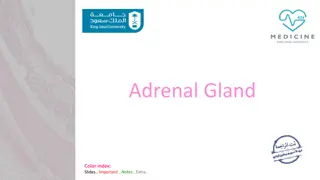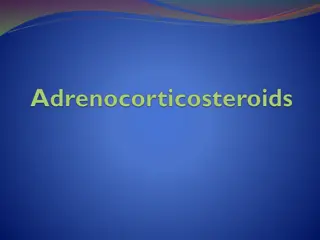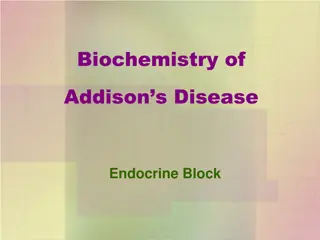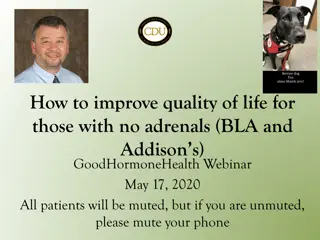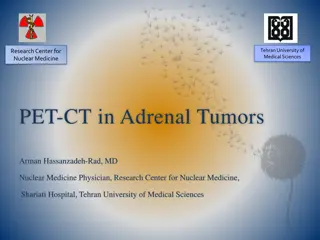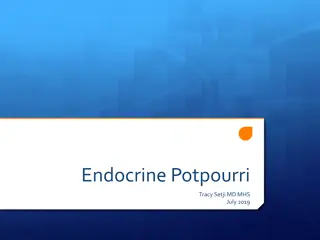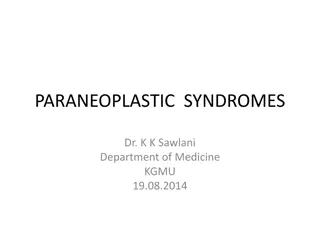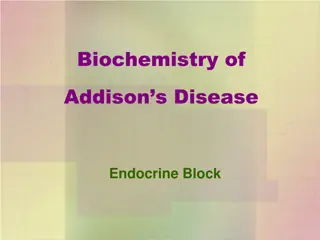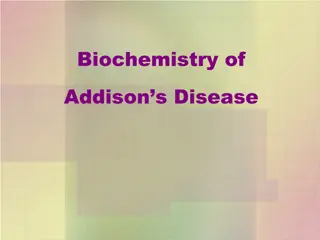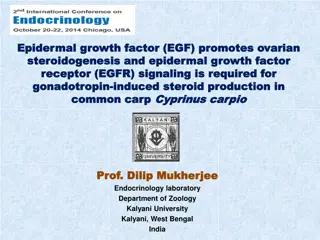Overview of Adrenal Steroidogenesis and CAH Syndromes
Adrenal glands play a crucial role in steroid hormone production and regulation. Learn about congenital adrenal hyperplasia (CAH) syndromes, adrenal steroidogenesis, and intersex conditions. Explore the functions of different adrenal hormones, the genetic mutations leading to CAH, and the clinical manifestations associated with these disorders. Gain insight into the complexities of adrenal function and the impact of enzyme deficiencies on cortisol production.
Download Presentation

Please find below an Image/Link to download the presentation.
The content on the website is provided AS IS for your information and personal use only. It may not be sold, licensed, or shared on other websites without obtaining consent from the author.If you encounter any issues during the download, it is possible that the publisher has removed the file from their server.
You are allowed to download the files provided on this website for personal or commercial use, subject to the condition that they are used lawfully. All files are the property of their respective owners.
The content on the website is provided AS IS for your information and personal use only. It may not be sold, licensed, or shared on other websites without obtaining consent from the author.
E N D
Presentation Transcript
HbA NH2 H2O2 Cl2O7 KClO3 NAOH CH2O PO4 KMnO4 M E D I C I N E COOH KING SAUD UNIVERSITY Co2 MgCl2 H2O SO2 Doctors slides Doctors notes Important ExtraInformation HCN CCl4 CuCl2 SiCl4 Editing file Biochemistry CAH and testicular feminization syndromes Editing file Say good bye to the basic sciences with doing your best in the last block
O B J E C T I V E S By the end of this lecture, the students should be able to know: Adrenal steroidogenesis 1. 2. 3. Congenital adrenal hyperplasia syndrome Types Biochemical characteristics Clinical manifestations Testicular feminization syndrome CAH stands for Congenital adrenal hyperplasia
Adrenal Glands to understand better The adrenal glands comprise 3 separate hormone systems Secrete aldosterone Zona Glomerulosa Adrenal Cortex secrete cortisol & the adrenal androgens Fasciculata and Reticularis secretes catecholamines (mainly epinephrine) Adrenal Medulla
Hermaphroditism or Intersex Intersex (for example) : a male with normal testis but has female external genitalia ( ( Female pseudo-hermaphrodite: a female with a male external genitalia Intersex: A person has neither standard male or standard female anatomy. Discrepancy between type of gonads and external genitalia True hermaphrodite (rare) (ovary plus testis) Female pseudohermaphrodite (FPH, only ovary) Male pseudohermaphrodite (MPH, only testis) Recall what you studied before Steroids with cortisol-like activity Potent metabolic regulators & immunosuppressants Glucocorticoids Steroids with aldosterone-like activity Promote renal sodium and water reabsorption, and excretion of potassium. Mineralocorticoids
Steroidogenesis & CAH syndromes YOU NEED TO UNDERSTAN THESE TWO SLIDES In congenital adrenal hyperplasia we have enzymatic deficiency leading to appearance of signs and symptoms. *Notice that any enzyme deficiency will lead to deficiency of cortisol. *Remember the hypothalamic-pituitary-adrenal axis: Hypothalamus (CRH) > Pituitary (ACTH) > Adrenal (cortisol) and high levels of cortisol will cause a negative feedback and stop the production of CRH and ACTH. So if we don t have cortisol we don t have negative feedback and ACTH will be continually produced leading to adrenal hyperplasia. *Aldosterone does not cause negative feedback to CRH and ACTH, it only causes negative feedback to renin- angiotensin system. . * Congenital Adrenal Hyperplasia Congenital : Due to mutation of the gene responsible for synthesis of the required enzymes Hyperplasia : Because we don t have cortisol
Steroidogenesis & CAH syndromes Cont. As you can see in the picture, we have 4 enzymes that could be deficient (21-alpha-hydroxylase being the most common) 1- 3-beta-hydrxysteroid dehydrogenase: a deficiency in this enzyme will lead to deficiency to all the end products and accumulation of pregnenolone. 2- 17-alpha-hydroxylase: a deficiency in this enzyme will lead to deficiency of cortisol, testosterone and estradiol and accumulation of progesterone and aldosterone Aldosterone accumulate because its pathway is the only pathway that remains intact so the whole amount of progesterone get converted to it , leading to hypertension. 3- 21-alpha-hydroxylase: it catalyzes two reactions, so a deficiency in this enzyme will lead to deficiency of aldosterone and cortisol and accumulation of 17-alpha-hydroxyprogesterone leading to accumulation of testosterone and estradiol. . 4- 11-beta-hydroxylase: a deficiency in this enzyme will lead to deficiency in cortisol and aldosterone and accumulation of 11- deoxycorticosterone (which has the same effect as aldosterone, but not stimulated by renin) and accumulation of 11-deoxycortisol and androstenedione leading to accumulation of testosterone and estradiol. The symptoms of this enzymatic deficiency are the same of that in 21-alpha-hydroxylase, the only difference is that 11-beta- hydroxylase deficiency patients have hypertension.
CAH syndromes Congenital Adrenal Hyperplasia Syndromes It is the result of an inherited enzyme defect in steroid biosynthesis The condition might be fatal unless diagnosed early due to water depletion and hypovolemia. Cannot secrete cortisol absent negative feedback to the pituitary) ACTH continues to drive steroid biosynthesis adrenal hyperplasia and accumulation of cortisol precursors (depending on which enzyme is lacking) Cannot secrete aldosterone electrolyte disturbances 1. Hyponatremia 2. Hyperkalemia 1. 21 -Hydroxylase deficiency 2. 11 -Hydroxylase deficiency 3. 17 -Hydroxylase deficiency 4. 3 -Hydroxysteroid dehydrogenase deficiency The adrenals CAH Syndromes
21 -Hydroxylase deficiency 17a-hydroxy- progesterone The most common type of CAH (90%) Progesterone Androstenedione Clinically: Complete enzyme defect: stimulation of adrenal androgen production virilization in baby girls & precocious puberty in boys. Partial enzyme defect late onset form menstrual irregularity & hirsutism in young females. Ok.. Since I can t proceed I m completing up there 21 a a-Hydroxylase I m not enough 11-Deoxycorticosterone 11-Deoxycortisol Testosterone Laboratory diagnosis: plasma [17- hydroxyprogesterone] as early as 4 days after birth In laboratory diagnosis, we measure the molecules not the enzymes. The most important molecule to be measure is 17-hydroxyprogesterone. Precocious sexual development in Virilisation of
21 -Hydroxylase deficiency Autosomal recessive condition Genetics Impaired synthesis of both cortisol & aldosterone [cortisol] ACTH secretion Adrenal gland hyperplasia Mutations in the CYP21 gene Deletions Nonsense Missense Accumulated 17 -hydroxyprogesterone are diverted to the biosynthesis of sex hormones signs of androgen excess: Ambiguous (we don t know if it s a female or a male) genitalia in newborn girls (FPH) DNA testing: Rapid postnatal growth in both sexes For prenatal diagnosis and confirmation of diagnosis Severe cases: mineralocorticoid deficiency salt & H2O loss hypovolemia & shock neonatal adrenal crisis Late presentation (adult life) is possible in less severe cases
21 -Hydroxylase Deficiency: Diagnosis Serum sample taken at least 2 days after birth (earlier samples may contain maternally derived 17-hydroxyprogesterone) Classic (complete) deficiency is characterized by markedly elevated serum levels of 17-hydroxyprogesterone ACTH is given to the patient and if the levels of 17-alpha-hydroxyprogesterone increase > the diagnosis is confirmed borderline results Late-onset (partial) deficiency may require corticotropin (ACTH) stimulation test: Measure base-line and stimulated levels of. 17- hydroxyprogesterone. High level of 17-hydroxyprogesterone after stimulation is diagnostic
11 -Hydroxylase Deficiency leads to high concentrations of 11-deoxycortisol Androstenedione Leads to high levels of 11-deoxy-corticosterone with mineralocorticoid effect (salt and water retention , hypertension) Suppresses renin/angiotensin system low renin hypertension Musculanization in females (FPH) and early virilization in males
To summarize Questions from this picture: *Which enzymatic deficiency would cause virilization? *Which enzymatic deficiency would cause deficiency of estradiol?
Testicular Feminization Syndrome (Androgen Insensitivity Syndrome) Control of testicular function by the gonadotrophins Disorders of Male Sexual Differentiation They are rare group of disorders The defect may be in: Testosteroneproduction (impaired testosterone production) Androgen receptors (inactive androgen receptors target tissues CANNOT respond to stimulation by circulating testosterone; e.g., Testicular feminization syndrome.
Testicular Feminization Syndrome In peripheral tissue, testosterone will be converted by aromatase into estradiol = feminization Clinical Picture Androgen receptor resistance leading to high testosterone blood level 46,XY karyotype X-linked recessive disorder Complete androgen insensitivity syndrome (CAIS): female external genitalia with normal labia, clitoris, and vaginal introitus (MPH) Patients have normal testes & produce normal amounts of m llerian-inhibiting factor (MIF) (the function of this factor is inhibition of the production of uterus and fallopian tubes), therefore, affected individuals Do Not have fallopian tubes, a uterus, or a proximal (upper) vagina. Partial androgen insensitivity syndrome (PAIS): mildly virilized female external genitalia (clitorimegaly without other external anomalies) to mildly undervirilized male external genitalia (hypospadias and/or diminished penile size)
Laboratory Diagnosis 1. Karyotype: differentiate an undermasculinized male from a masculinized female. 2. Fluorescent in situ hybridization (FISH): Presence of a Y chromosome can be confirmed by probes for the SRY region of the Y chromosome. These offer a much quicker turnaround time than conventional karyotypes. 3. Increased (or normal) testosterone and dihydrotestosterone blood levels DNA tests and mutation analysis for androgen receptor gene: 4. Complete or partial gene deletions, point mutations, or small insertions/deletions Imaging Studies Pelvic ultrasound : Absence of fallopian tubes and uterus 5.
Summary Autosomal recessive based on severity of enzyme defect: complete enzyme defect increase adrenal androgen production partial defect late onset (menstrual irregularity) severe cases: mineralcorticoid defeciency leads to hypovolemia and shock (neonatal adrenal crisis) Accumulated 17-a-hydroxyprogesterone > sex hormones Signs: ambiguous genitalia and rapid postnatal growth Lab: high plasma 17 hydroxyprogesterone(4 days after birth) classic: elevated serum levels of 17 hydroxyprogesterone late onset: ACTH stimulation test shows high 17 hydroxyprogesterone genetics: mutation in CYP21 prenatal testing to confirm and diagnose 21-a-hydroxylase high levels of 11 deoxycortisol and 11 deoxy-corticosterone salt and water retention suppress renin/Ag system> low renin hypertension Decrease in cortisol, aldosterone, and corticosterone clinical picture: masculinization in females and early virilization in females 11-B-hydroxylase
QUIZ Q1 : Which of the following is the most common cause of congenital adrenal hyperplasia? A. 21 alpha hydroxylase deficiency B. 11 beta hydroxylase deficiency C. 17 alpha hydroxylase deficiency D. 23 beta hydroxylase deficiency Q4 : Active estrogens absent glucocorticoids and absent mineral corticoids is related to which one of the following? A. 17-alpha hydroxylase deficiency B. 21-alpha hydroxylase deficiency C. 11-Beta hydroxylase deficiency D. 3 Beta hyroxysteroid dehydrogenase deficiency Q5 : Which of the following explains testicular feminization syndrome ? A. Androgen receptors resistance B. Deficiency of hormones C. Hypothalamus pituitary axis defect D. X-linked dominant disorder Q2 : Which of the following is a late complication of partial 21 alpha hydroxylase deficiency ? A. Virillization in baby girls B. Precocious puberty in boys C. Gigantism D. Hirsutism Q6 : Which of the following is correct about complete androgen insensitivity ? A. XY karyotype with external female genitalia B. Mildly virilized female external genitalia C. Undervirilized male external genitalia D. Hypospadias Q3 : Which one of the following leads to high concentration of 11- deoxycortisol? A. 21 alpha hydroxylase deficiency B. 11 beta hydroxylase deficiency C. 17 alpha hydroxylase deficiency D. 23 beta hydroxylase deficiency
QUIZ Q7 : 8 month old infant was brought to your clinic with his mother. She says that her son has weird looking genitalia for his gender, her husband told her that she is imagining things but she insisted on visiting a physician. Upon clinical inspection and examination you found that her son has female genitalia. Upon karyotyping, XY karyotype was found. C) Name 3 tests used to diagnose this condition. 1. Karyotype 2. FISH 3. DNA tests and maturation analysis for androgen receptor gene D) How can we make sure of absence of uterus and Fallopian tubes in this condition? Through imaging studies, specifically the pelvic ultrasound. A) Mention the name of this condition. Complete androgen insensitivity syndrome. B) Explain the clinical presentation of this condition. Male infant but with external female genitalia and female exterior caused by androgen receptor insensitivity. Suggestions and recommendations Suggestions and recommendations 1) A 2) D 3) B 4) D 5) A 6) A
THANK YOU FOR CHECKING OUR WORK T E A M M E M B E R S TEAM LEADERS PLEASE CONTACT US IF YOU HAVE ANY ISSUE Abdulaziz alhusaini Mohammad Almutlaq Rania Alessa Mohannad alzahrani Abdulrahman alrashed Heba alnasser Badriah alsabbagh Najd altheeb


